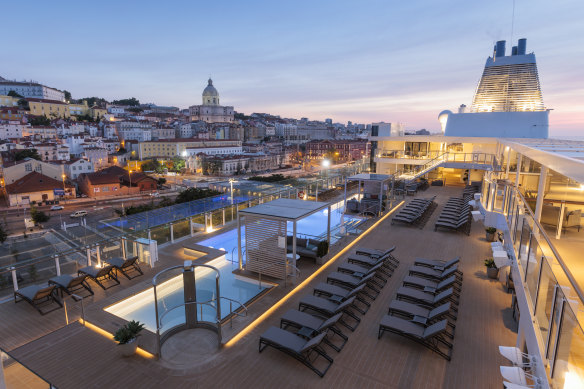Technology is transforming the way we cruise
It sounds like a relatively minor First World niggle, but scratchy internet has been the bane of cruise-goers’ lives since it was first launched on ships in 1999. It was very expensive and often dismally slow. Not any more, though.
Technology has improved and the COVID pandemic encouraged remote working. If you’ve cruised post-pandemic, you’ll have noticed speedy internet is the result. Cruise lines are now eyeing up the remote-worker market, with Azamara, Virgin Voyages and AmaWaterways at the forefront.

Utopia of the Seas’ Royal Railway Utopia Station takes guests on a virtual train journey.
Another reason cruise ships now require good internet? Shipboard life is becoming increasingly digital, especially on large, budget-end ships from the likes of Carnival, Norwegian, Princess and Royal Caribbean.
Cruise apps arrived just before the pandemic, but were more enthusiastically embraced afterwards for their ability to reduce person-to-person contact. Now they’re blooming. Guests can reserve dining tables and shore excursions and access information straight from their phones.
Virtual assistants and touchscreens have appeared, too. So have gadgets such as Princess Cruises’ Medallion, a wearable disc that tracks you around the ship – useful when you want those cocktails delivered – and can be used as a charge card, or to open your cabin door.
Even before boarding a ship, virtual reality tours give you a flavour of what to expect. Virtual reality innovation is accelerating. Some cruise lines even have virtual windows in inside cabins that project scenery relayed via cameras.
Royal Caribbean’s new Royal Railway Utopia Station restaurant on its just-launched Utopia of the Seas, which resembles a railway dining carriage, takes guests on a “journey” as virtual scenery unfolds beyond the windows.
The restaurant doesn’t actually move, but in future we might find more flexible spaces on cruise ships. Already, Royal Caribbean’s Rising Tide Bar moves up and down ship interiors, while Celebrity’s latest vessels go one better with Magic Carpet, a cantilevered platform which can be used either as a tender platform or an open-air restaurant/bar, 13 decks above the ocean.
Magic Carpet brings a touch of asymmetry to Celebrity’s Edge-class ships, but innovative design in ships such as TUI Cruises’ Mein Schiff 7, launched this year, is moving away from a traditional, symmetrical layout along a central axis.
Silversea’s latest vessels Silver Nova and Silver Ray feature corridors, smokestacks, some restaurants and most strikingly a swimming pool located to one side. The result is a pool deck more reminiscent of a boutique hotel than cruise ship.

Silversea’s newest ship, Silver Ray, at port in Lisbon.
Something else you’ll likely be seeing more often? A noticeable change in cruise-ship design has been the bows of big ships such as those of Celebrity and Norwegian, and expedition ships such as those of Aurora Expeditions.
Sharper or otherwise alternatively shaped bows are partly about greater stability, partly about fuel efficiency. Less noticeable sustainability innovations include waste-management systems, solar panels, wind turbines and alternative fuel sources.
Meanwhile Hurtigruten is developing a zero-emission battery-powered ship with solar-panel-lined metal sails. Ponant, too, is eyeing up sails in the hope of producing a zero-emission, wind-assisted cruise ship.
Sometimes innovation, it seems, involves a return to old-fashioned technologies.
Sign up for the Traveller Deals newsletter
Get exclusive travel deals delivered straight to your inbox. Sign up now.